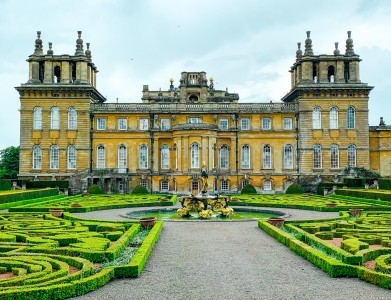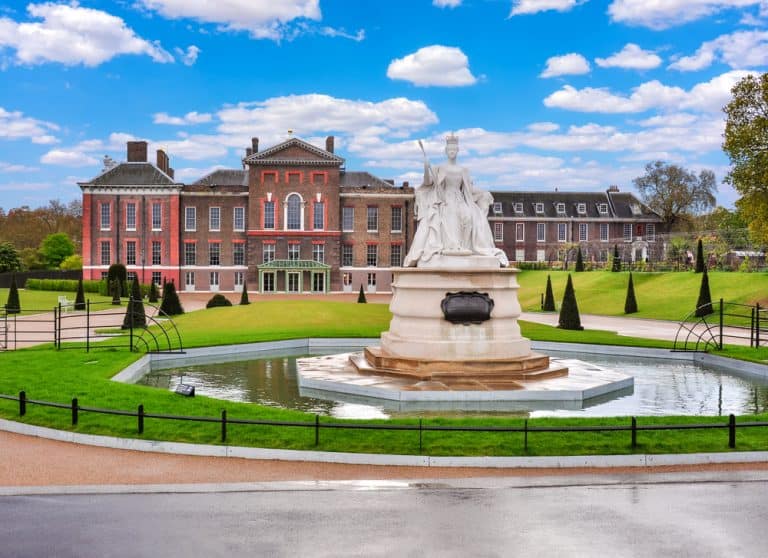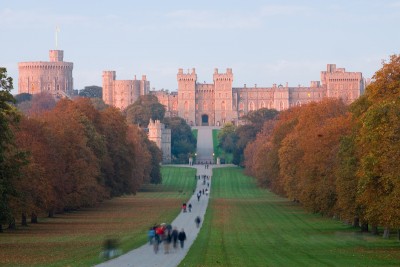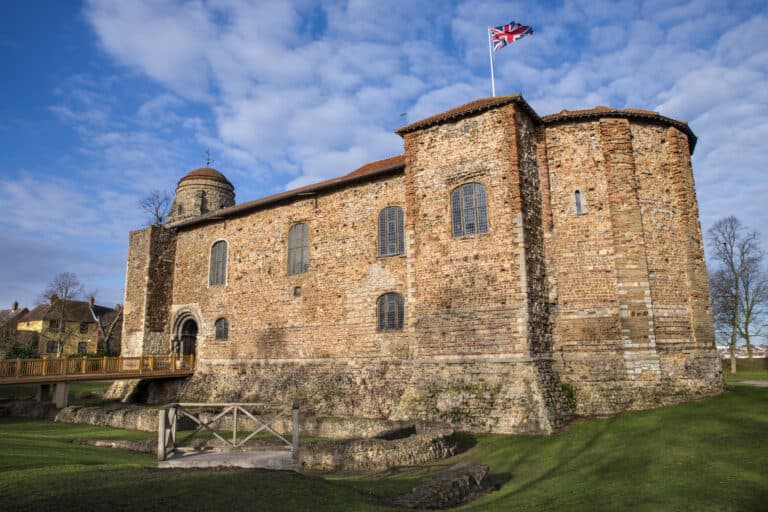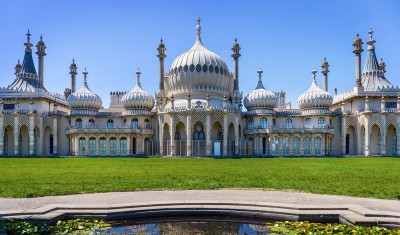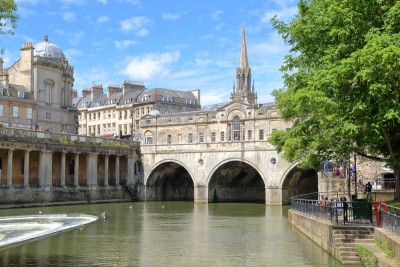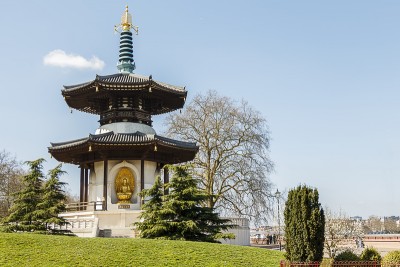Visiting Blenheim Palace: all you need to know
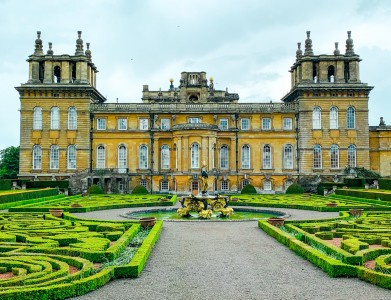
Blenheim Palace is an 18th century stately home originally built for John Churchill, the first Duke of Marlborough. Its construction was to honour his pivotal role in defeating France at the Battle of Blenheim in 1704.
The house has remained in the Marlborough family ever since and is now a UNESCO World Heritage site.
It is also apparently the only non-royal and non-episcopal house in the country to be called a palace.
Despite being a private residence (it is the current home of the 12th Duke and Duchess of Marlborough), the public can visit and marvel at the wonderful baroque architecture and gardens. You can also learn about the fascinating history of Blenheim Palace.
As you stroll around this stately home and its grounds, you’ll discover that former Prime Minster Sir Winston Churchill was born here, and that it was used as a hospital during the First World War.
The famous landscape gardener Capability Brown also designed some of the 2,000 acre grounds in which it sits.
So, if you are interested in history and architecture, or fancy wandering around beautiful and peaceful gardens, this is one to put on your list for a day out in the UK.
Read on for further information about visiting Blenheim Palace.
Written by Emma Marshall
This post contains affiliate links
Where is Blenheim Palace?
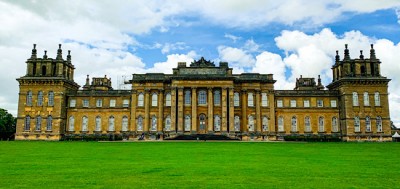
Blenheim Palace is on the edge of Woodstock, a small town in the English county of Oxfordshire. It is around 10 miles from Oxford, which is about a 20 minute car drive.
The palace is also just over 60 miles from London, making it a perfect day trip from the capital. Birmingham is less than 80 miles away.
How to get to Blenheim Palace
Given its proximity to Oxford, London and Birmingham, Blenheim Palace is an easy day out. If you drive, there’s a large, free, car park on site where you can park.
If you prefer to travel by public transport, you can catch a train to several nearby stations (Oxford, Oxford Parkway or Hanborough). You can then pick up a local bus to the entrance.
The palace website provides further details of which buses to catch, as well as buses you can take from other nearby towns.
You can also book organised day trips. These have the advantage of providing a tour guide who can furnish you with information on the sights and history as you make your way around.
Blenheim Palace tickets
You can book tickets for a visit here.
You can also book guided tours from Oxford.
Or alternatively private tours from London can be organised.
As with many sites at the moment, it is important that you book your tickets in advance to avoid disappointment.
What to see and do when visiting Blenheim Palace
There’s a wealth of attractions on offer if you do a day trip to Blenheim Palace.
To some extent, what you prioritise may depend on the weather when you visit. But even if the weather is unpredictable, there’s more than enough to justify your trip.
It’s also a place where both adults and children will find something they like.
Read on for all you need to know about visiting Blenheim Palace and the different things to see and do.
Blenheim Palace State Rooms
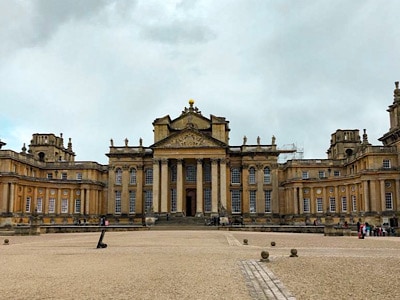
The Blenheim Palace State Rooms is one of the main draws here. They epitomise everything that one associates with stately homes.
Full of grand rooms with plush furnishings and carpets, art hanging off the walls and ornate ceilings and light fittings, it definitely fits the description of a palace, even if it isn’t officially royal.
The entrance for the State Rooms is an airy hall with large windows providing plenty of light. There is a striking mural on the ceiling.
You are then taken on a route around some of the smaller rooms and corridors where you can see impressive collections and commissions representing different historical periods.
This includes a collection of Meissen porcelain, gifted from the King of Poland to the 3rd Duke of Marlborough in the mid 18th century, and the military scenes depicted in the Blenheim Tapestries.
There is also a statue of Queen Anne that was ordered to be made by the very first Duchess who lived here.
You can explore the different rooms and marvel at their interiors as well as learn about their uses over the centuries. There’s the Saloon, originally a reception room and now a dining room that is still used on special occasions.
A dinner table is laid out here to give you an impression of how it would look in reality.
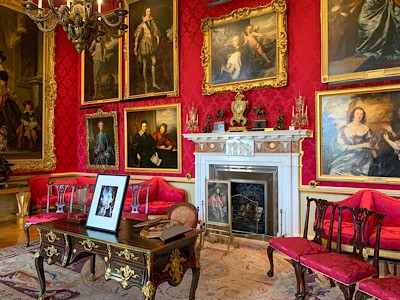
The Second State Room is a small but grand room with a fireplace and ornate desk in the centre. According to the information provided when we visited, this was once used for students from a nearby college who were evacuated here during the Second World War.
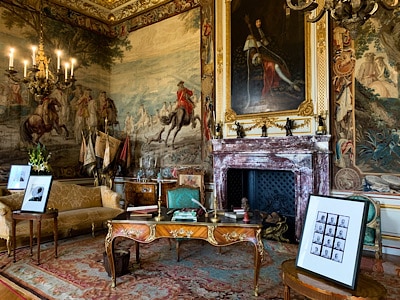
There’s also the Long Library – probably my favourite room of all. You will find a grand piano, some sofas and chaise longues in here. These help you imagine what it must be like to sit relaxing in this room leafing through a good book plucked from the surrounding bookcases.
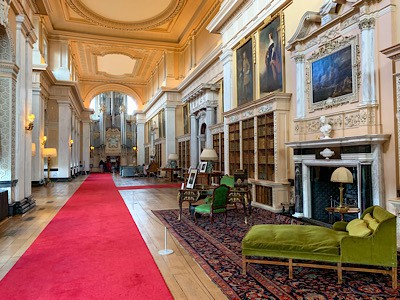
However, the room started out as a picture gallery and then during the Second World War, it doubled as a dormitory for the evacuated students. An image of the students sitting on the lined up beds is displayed.
Architecturally, the room is light and airy which (unsurprisingly) is long (183 feet) and narrow with a thin red carpet. This leads up to a massive 19th century organ at the far end.
At the opposite end, you can see the statue of Queen Anne.
The Churchill exhibition
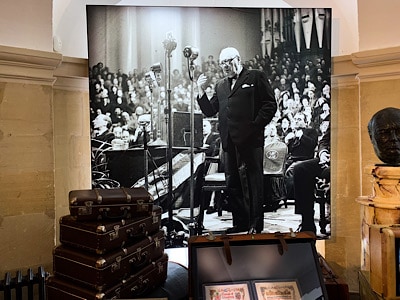
You might be visiting Blenheim Palace for the State Rooms or for the extensive outdoor grounds, but even if you are, you really mustn’t miss this fascinating and informative exhibition.
Although it is fairly small, it packs in a wealth of information about arguably Blenheim’s most famous family member.
Before I visited, I didn’t realise the extent of Churchill’s connection to Blenheim Palace (his uncle was the 8th Duke of Marlborough) and that he was born here in November 1874. It was also here that he proposed to his wife, Clementine, by the Diana Fountain in the gardens.
You should start by taking a quick look at the gorgeous black car parked in the courtyard in front of the State Rooms. According to one of the guides outside the exhibition, this is one of Churchill’s own cars.
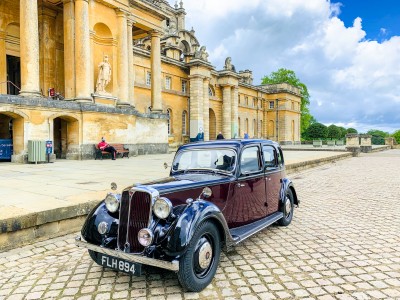
The museum displays artefacts from Churchill’s past, including items that depict the eras in which he grew up or activities he was fond of.
You’ll get to see military uniforms, the vest he wore as a baby, and the seat that he used to sit in when he was riding the horses on the estate as a young boy. There’s also the ‘red box’ (or despatch box) that he used when he was Secretary of State for War.
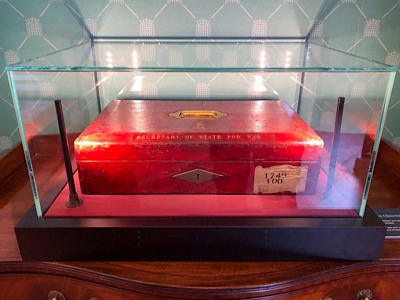
There are images of Churchill on the walls, old photographs and quotations of things he famously said. The information provided as you walk around the exhibition is a fascinating summary of his remarkable life.
The final room in the exhibition is set up to illustrate Churchill’s home life. This includes a breakfast table (complete with a smoking cigar in an ashtray), and an armchair with a radio and bottle of whisky beside it.
There are also some easels and paintings displayed. These highlight his love of painting in the grounds of the palace.
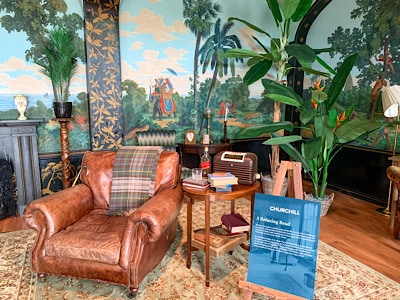
Entry to this exhibition is part of your ticket to the palace and gardens.
Blenheim Palace grounds
Part of what makes Blenheim Palace so special is its grounds. And they are huge – as you’ll see in this downloadable map.
I’d wholeheartedly recommend making time to explore them on your visit here. It also gives you the opportunity to look back at the different sections of the palace and admire its architecture.
The Formal Gardens and South Lawn
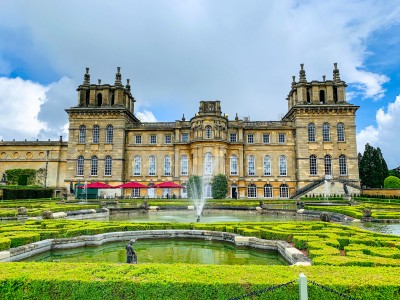
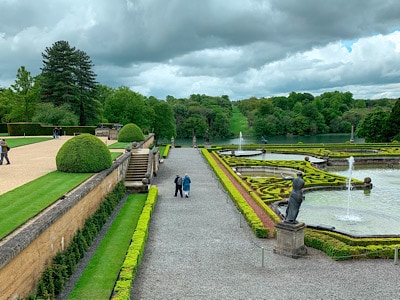
The gardens nearest to the palace buildings are known as the Formal Gardens. These immaculately designed gardens include a private Italian Garden (unfortunately you can only look over into this; you can’t enter) and the Water Terraces.
In addition, you can see the Rose Garden and the Secret Garden, a more secluded part of the gardens with colourful shrubs and flowers.
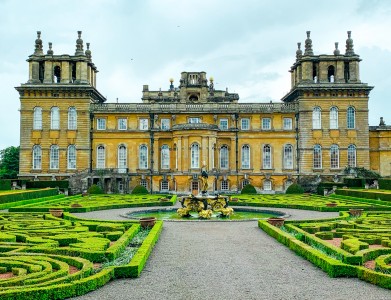
In the Formal Gardens, you’ll also find the Diana Temple, the site of Churchill’s proposal to his wife back in 1908.
A short walk away on another side of the palace building is the South Lawn. Although this is really just a large open expanse, it’s worth walking out on to this vast lawn space for the views of the palace.
From this vantage point, you really appreciate how beautiful this historic building is.
The Walled Garden
If you walk further beyond the South Lawn, you’ll come to the Walled Garden. This part of the gardens will particularly appeal to families with children.
It contains the Marlborough Maze, a puzzle consisting of two miles of yew trees, along with a butterfly house and a children’s play area. If you don’t fancy the 10-minute walk here, you can hop on the miniature train for extra fun.
There is also a café and restaurant serving pizza.
The Great Lake and Queen Pool
Blenheim Palace is blessed with several peaceful areas of water that you can wander along. Apparently designed and created by Capability Brown in the 18th century, the Great Lake is the largest expanse of water. It can be found near the Formal Gardens and palace.
You can walk along the water’s edge in parts and look over to the small boathouse and Pump House that sit on the water’s edge (unfortunately, however, you can’t access them).
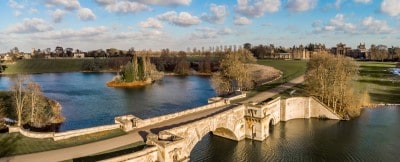
The Queen Pool, the smaller area of water, is not far from the palace and is separated from the Great Lake by Vanbrugh’s Grand Bridge. Further ahead you can’t miss the massive Column of Victory.
Blenheim Palace walks
The grounds are so extensive that it’s really easy to spend hours walking around them should you wish to do so and the weather permits. The website lists different walks, covering ones that are under a mile to over 4.5 miles.
Click here for more information.
The stables
The Blenheim Palace stables exhibition gives an insight into the Marlborough family’s love of horses. There are individual stable blocks that you can peek into.
There’s also the old tack room and office area where you get a glimpse of the extensive range of equipment that was needed to look after the estate’s horses.
Children will love this part. There is a model of Churchill’s pony Rob Roy here, an old-fashioned carriage, as well as the opportunity to try out riding a horse side saddle.
Blenheim Palace afternoon tea
If you fancy something a bit special, then you can book afternoon tea as part of your trip. We did this as part of a birthday gift and the glasshouse surroundings in which you have afternoon tea are lovely.
A mixture of sweet and savoury indulgences, it was more than enough to make up for the fact that we ate breakfast early to make the drive from London.
The scones with jam and clotted cream and the small petit four cakes were delicious. But for me it was the quite unique addition of miniature warm chicken and mushroom pies and tiny rarebits – in addition to the obligatory finger sandwiches – that made it memorable.
Plus the glass of champagne on the side!
On fine days you can take your afternoon tea outside on the terrace of the Orangery overlooking the Italian Garden.
The miniature train
If you fancy taking the weight off your feet, or having a bit of fun with the kids, then hop on the miniature train that runs through part of the grounds. This is a great way to see things at a more leisurely pace.
The train runs from 11am and connects the palace buildings to the Walled Garden (if you have time, give the maze a go while you’re here).
There is no official fee to take the train, but donations of £1 each way are appreciated.
Blenheim Palace opening times
The palace opens at 10am every day and is open until 4.15pm, with final entry half an hour before. The gardens open at 9.30am and close at 5pm.
You need to pre-book entry to all areas at the moment.
The train runs all day from 11am.
Eating and drinking at Blenheim Palace
There are plenty of places to grab a bite to eat in the palace. This includes the Oxfordshire Pantry and the Stables Café which serve cakes and snacks.
There is also the Orangery Restaurant if you’re after a more substantial meal, or fancy afternoon tea. Or if you fancy pizza, head for the Pizza Café in the Walled Garden.
On fine days, there is plenty of outdoor seating in the cafes and restaurants.
You can also buy a Searcys picnic to eat in the grounds. There are three different options for picnics, depending on whether you opt to include champagne in it.
Top tips for visiting Blenheim Palace
Based on my experience of visiting Blenheim Palace, there are a few tips I’d suggest:
- Book your tickets in advance to avoid disappointment, especially at the moment when visitor numbers need to be reduced.
- If you can, try to arrive a little earlier than your allocated slot: there is a car park in the grounds, but it is a bit of a walk to the main parts of the complex.
- If you visit on a cold or rainy day, take an umbrella and a jumper! At the moment, you have to queue outside for your allocated time slot to the State Rooms. The grounds are also stunning, so you don’t want to miss out on them just because the weather isn’t great.
- Don’t miss the fabulous Churchill exhibition which is located next to the State Rooms. It’s a fascinating insight into one of the family’s most famous members.
- For children, ride on the train through the grounds, pop into the stables to try out riding a horse and see the butterflies in the Walled Garden.
- If you’re looking for something special as part of your day out, book afternoon tea on the terrace of the Orangery overlooking the Italian Garden. Alternatively, a champagne picnic in the palace grounds would be romantic.
Other ideas for UK day trips
I hope this gives you enough information on visiting Blenheim Palace to whet your appetite.
If you’re looking for ideas for other UK days out, then you may be interested in some of my other posts:
A day out at Hampton Court Palace

